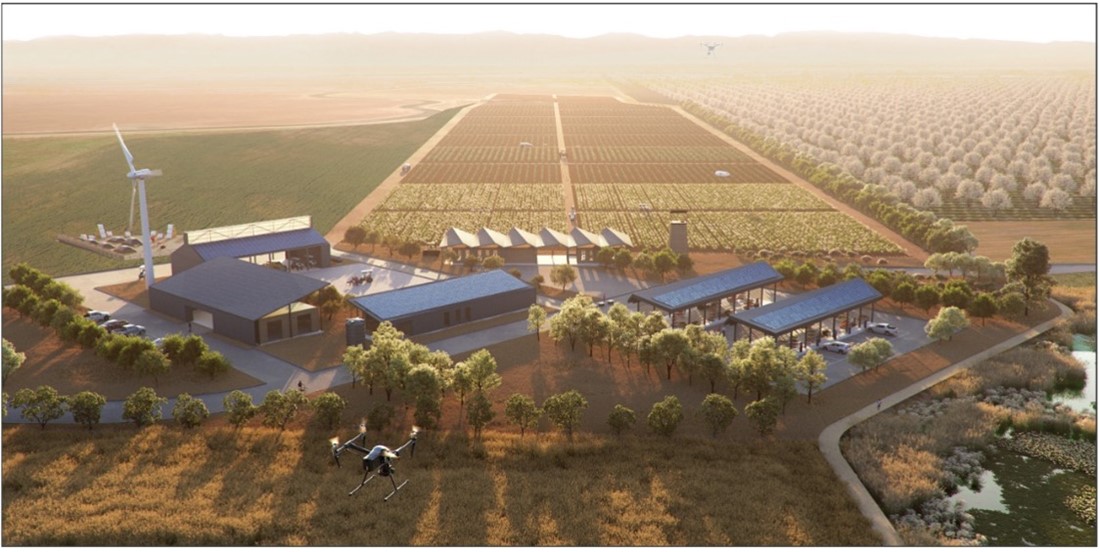What we did / How we did it (Katelyn)
Each tree was mapped, species identified, and photographed. Locations of each tree were mapped using a hand-held Garmin GPS unit. Species identifications were found using Seek App from iNaturalist. Photographs of the whole tree, leaves, flowers, and fruit, if possible were taken. This information can all be found in each waypoint of the map.
Where to Visit
Drought Tolerant Quad Waypoint 1

The design of the academic quad located between the Arts & Computational Sciences (ACS) and Sustainability Research & Engineering (SRE) buildings stands out. Just by walking through this area, you may notice it looks a bit different from other areas. Sustainability and biodiversity were kept into consideration while designing this area to conserve water and still look nice. The green trees throughout the quad are Palo Verdes, which are drought tolerant. While Palo Verdes are not native to California, they are from Southwestern US and Mexico, so they are able to withstand dry conditions. The trees bloom yellow flowers with a fresh scent in late spring/summer and would be a nice area to visit.
Valley Oak Grove Waypoint 59

There is a grove of Valley Oak trees in the area between the Student Services Building (SSB) and Social Sciences & Management (SSM) building. Valley oaks are native to California. These trees attract fauna, most notably wasps. A unique and unexpected sight to see: thea wasp community being supported by the oak trees.! Wasps can make galls in the trees and then live safely inside. If you’re in this area, like always, enjoy the outdoors, take time to relax in some shade, and respect the biodiversity.
Scholar’s Lane Plum Blossoms Waypoint 67

Photo Credit: Vernoica Androver
Along Scholar’s Lane, there is a line of planters with trees that have pink blossoms during the springtime. Many think that these are cherry trees, but they are actually Purple leaf plum trees. These trees attract pollinators such as bees with their blossoms and the planters themselves are a nice spot to stop for a break and take in a diversity of other trees around campus, including the drought-tolerant Chinese Pistache and Gingko Biloba nearby
Garden

The UC Merced Campus Garden (also known as the Bobcat Garden) was founded in 2010 by Master Gardener De Ette Silbaugh along with a group of students and sustainable engineers. The mission of the Bobcat Garden is threefold. First, to provide nutritious and fresh produce to the Bobcat Pantry on campus, fighting food insecurity; second, to model sustainability on campus through eco-friendly projects; and third, to educate students, faculty, and staff about gardening and foster a community of environmentally conscious gardeners. These goals are achieved through growing various fruits and vegetables in our space of over 25 beds as well as hosting various workshops with experts in the fields of gardening and sustainability.
The garden is totally supported and sustained by students and welcomes new volunteers on a weekly basis. Everyone is encouraged to visit the garden near the Valley Terraces on Rancher's Road as well as the orchard near the North Bowl Lot.
https://ucmcampusgarden.ucmerced.edu/
Orchard
In 2021, we were privileged to open our campus fruit orchard, increasing our ability to provide much more variety and quantity of fresh produce for the entire campus as it grows. It can be found adjacent to North Bowl Lot 2. Currently we have pomegranate, figs, peaches, nectarines, apples, and many citrus trees! If you are ever interested in volunteering in the orchard or garden reach out to campusgarden@ucmerced.edu for more information!
Experimental Smart Farm

The UC Merced Experimental Smart Farm (ESF), an initiative launched in Fall 2021, is envisioned as a functional campus showpiece: the farm of the future. Slated to occupy approximately 45 acres near the southern boundary of campus land, it will provide world class facilities and infrastructure designed to support research convergence at the intersection of agricultural technology development, environmental sustainability, and workforce evolution. This includes (1) growing convergence research in technology and automation, environmental sustainability and health, and equitable access to healthy food and rewarding work, (2) harnessing the data revolution through continuous acquisition and synthesis of farm input/output and sustainability metrics of water, carbon, and other abiotic and biotic variables, (3) studying and informing the future of work in the form of human-machine collaboration, while (4) creating more inclusive education and career pathways in the agri-food value chain. California’s San Joaquin Valley, one of the most lucrative farming regions in the United States, is also sadly distinguished by its disadvantaged communities and environmental justice issues associated with undesirable working conditions, poor air quality, and (ironically) inaccessibility to clean water and healthy food. The ESF will serve as hub of activity for training a new generation of diverse and inclusive convergence-thinkers in irrigation engineers, roboticists, bioengineers, agroecologists, and other disciplines through forging strong collaborations and partnerships with other local and regional college and community college HSIs.
This unique infrastructure offers exciting new opportunities to advance our understanding of biodiversity as it intersects with both crop and non-crop organisms. For example, automated sampling and monitoring can produce community-level taxonomic identification from soil, water, air, plant, and fecal samples using environmental DNA and RNA monitoring via whole genomic sequencing, metabarcoding, targeted assays and other methods. Correlation of community and species identifications with continuously monitored abiotic variables at multiple scales on the ESF will yield insights into the value of biodiversity in agricultural settings, biodiversity-human interactions, ecology of critical crop pathogens, and much more.



